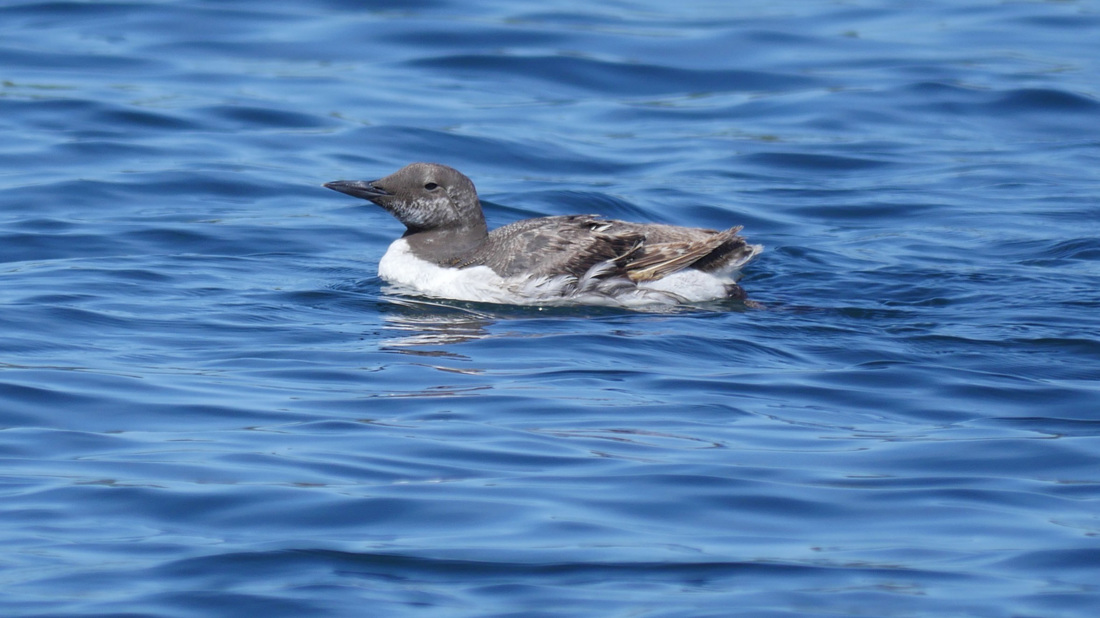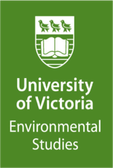Common murre • Uria aalge
Identification
The common murre is an alcid — a family of birds known as the "penguins of the north," and often called "flying footballs" for their rotund body shape. This is an apt description of the common murre in flight. It is large (to 45 cm long), and has a long, thing, pointed black bill, black legs. Its wings are black on top and partially white underneath, and its dark grey-brown back and head contrast against white undersides. In its summer breeding plumage the black section extends over its entire head and neck, while in winter its neck, chin, and sides of its head remain white with a dark line extending back from each eye. The juvenile plumage is similar to the female, but with a white line extending back from each eye.
Habitat & Range
The common murre forms breeding colonies on sea cliffs along the west and northeast coastlines of North America. It is a year-round resident at many of these locations, though birds nesting in the northernmost colonies move south when waters freeze in winter. Common murres may be seen in both coastal and offshore waters.
Find more information at the British Columbia Breeding Bird Atlas here.
Similar Species
Similarly-coloured alcids found along the Central Coast include the pigeon guillemot (winter plumage), the marbled murrelet (winter plumage), and the ancient murrelet. A closer look should make the plumage and shape differences obvious.
Intriguing Info
Breeding pairs lay a single egg at a time. Eggs can be very variable in colour, and are very pointy on one end. The variable colouring may help parents recognize their own eggs, while the shape causes eggs to spin in a circle when dislodged, thus preventing them from falling off the sea cliff nesting sites.
The common murre is a species of special concern in BC, as 95% of the British Columbia population of this species breeds in one colony on Triangle Island. This means the population is very susceptible to collapse from a catastrophic event impacting this breeding site. The three other breeding locations are on Sartine Island off the northern tip of Vancouver Island and the Kerouard Islands in Haida Gwaii.
The common murre is an alcid — a family of birds known as the "penguins of the north," and often called "flying footballs" for their rotund body shape. This is an apt description of the common murre in flight. It is large (to 45 cm long), and has a long, thing, pointed black bill, black legs. Its wings are black on top and partially white underneath, and its dark grey-brown back and head contrast against white undersides. In its summer breeding plumage the black section extends over its entire head and neck, while in winter its neck, chin, and sides of its head remain white with a dark line extending back from each eye. The juvenile plumage is similar to the female, but with a white line extending back from each eye.
Habitat & Range
The common murre forms breeding colonies on sea cliffs along the west and northeast coastlines of North America. It is a year-round resident at many of these locations, though birds nesting in the northernmost colonies move south when waters freeze in winter. Common murres may be seen in both coastal and offshore waters.
Find more information at the British Columbia Breeding Bird Atlas here.
Similar Species
Similarly-coloured alcids found along the Central Coast include the pigeon guillemot (winter plumage), the marbled murrelet (winter plumage), and the ancient murrelet. A closer look should make the plumage and shape differences obvious.
Intriguing Info
Breeding pairs lay a single egg at a time. Eggs can be very variable in colour, and are very pointy on one end. The variable colouring may help parents recognize their own eggs, while the shape causes eggs to spin in a circle when dislodged, thus preventing them from falling off the sea cliff nesting sites.
The common murre is a species of special concern in BC, as 95% of the British Columbia population of this species breeds in one colony on Triangle Island. This means the population is very susceptible to collapse from a catastrophic event impacting this breeding site. The three other breeding locations are on Sartine Island off the northern tip of Vancouver Island and the Kerouard Islands in Haida Gwaii.
References
B.C. Conservation Data Centre. (2015). Conservation Status Report: Uria aalge. B.C. Minist. of Environment. Accessed 27/10/2015.
Common Murre Uria aalge. Audubon Birds. National Audubon Society. Accessed 27/10/2015.
Common Murre Uria aalge. The Birds of North America Online (A. Poole, Ed.). Ithaca: Cornell Lab of Ornithology. Retrieved from the Birds of North America Online. Accessed 27/10/2015.
Dunn, J. L. and Alderfer, J. (Eds.). (2011). National Geographic Field Guide to the Birds of North America. (6th Ed.). Washington, D.C.: National Geographic Society. Pp. 252-253.
Why Is A Murre Egg Pointed And Spotty? Audubon Bird Cams. Accessed 27/10/2015.
Authors and editors of page
Kelly Fretwell
B.C. Conservation Data Centre. (2015). Conservation Status Report: Uria aalge. B.C. Minist. of Environment. Accessed 27/10/2015.
Common Murre Uria aalge. Audubon Birds. National Audubon Society. Accessed 27/10/2015.
Common Murre Uria aalge. The Birds of North America Online (A. Poole, Ed.). Ithaca: Cornell Lab of Ornithology. Retrieved from the Birds of North America Online. Accessed 27/10/2015.
Dunn, J. L. and Alderfer, J. (Eds.). (2011). National Geographic Field Guide to the Birds of North America. (6th Ed.). Washington, D.C.: National Geographic Society. Pp. 252-253.
Why Is A Murre Egg Pointed And Spotty? Audubon Bird Cams. Accessed 27/10/2015.
Authors and editors of page
Kelly Fretwell




